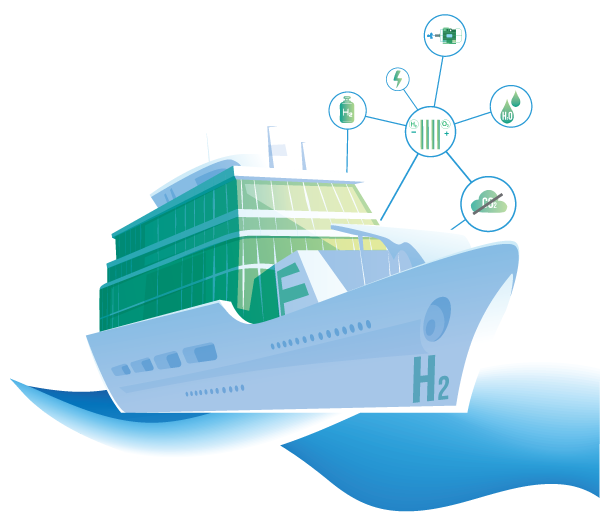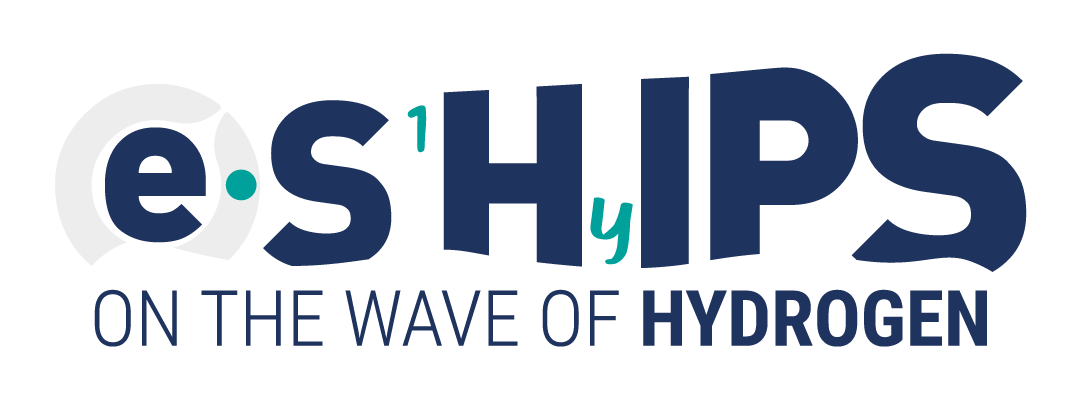Project overview
The maritime passenger transport industry plays a key role in the development of a competitive and resource efficient transport system in the European Union (EU).
Recently, the International Maritime Organization (IMO) has adopted a strategy to reduce international shipping emissions by 50% up to 2050, compared to 2008. This bring new opportunities towards the adoption of carbon-free fuels, with the hydrogen being the most promising. Given the fleet growth up to 2050 and the needs for a global maritime transportation, the reduction of CO2 emissions demands indeed novel energy efficient technologies, which other commonly used fuels can only support to some extent.
International standards and rules to certify safety on-board and environmental safety standards of hydrogen-based fuels ships, however, are not yet available in the context of passenger transport.
The e-SHyIPS project aims to define the new guidelines for an effective introduction of hydrogen in maritime passenger transport sector and to boost its adoption within the global and EU strategy for a clean and sustainable environment, towards the accomplishment of a zero-emission navigation scenario.

Through an ecosystem approach, where all the main stakeholders from maritime and hydrogen sectors, research and industry will be involved, the e-SHyIPS project will integrate theoretical pre-normative research activities on standards with simulation and laboratory experiments, in order to provide the needed knowledge to design an appropriate certification process and spot future standardization activities to enhance the EU normative and regulatory landscape.
The goal of the e-SHyIPS project is to move from the idea to the application, such as to fill the existing gap in normative and technical knowledge concerning all the related aspects on hydrogen in the maritime transport sector.
The e-SHyIPS project will last 48 months and it will take advantage from a structured programme based on five main lines of research.


e-SHyIPS PILLARS
The e-SHyIPS project is grounded on a structured programme based on 5 Pillars, each one representing a line of research and activities.
Pre-standard plan definition and hydrogen economy roadmap in maritime sector
The knowledge and experience gathered by means of the 5 Pillars will lead to the definition of pre-normative standards for the arrangement, installation and use of machinery, equipment and systems on hydrogen-fuelled vessels, thus aiming at minimizing the risk to the ship, its crew, passengers and the environment. A pre-standardization plan for the IGF code update for hydrogen-based fuels passenger ships will be then provided. The exploitation of the pre-standardization plan, the knowledge gathered from the hydrogen-maritime ecosystem and its international networking will result in a Roadmap for the hydrogen economy boost in the maritime sector.
PILLAR 1: State of the Art and theoretical studies
Nowadays, a regulatory framework applicable to Hydrogen-based fuels ships is not yet available and the only approach is given by IMO generic ‘Alternative Design’ process, where safety, reliability and dependability of the systems is to be proven equivalent to that of traditional fuels and power generation systems. e-SHyIPS activity starts with a deep analysis of the current state of the art and practice of the use of Hydrogen-based fuels in maritime and other transport and energy sectors, performing normative and technical knowledge gap analysis. For this activity, beside the consortium expertise, a wide stakeholders ecosystem will be used. The resulting state of the art will be the baseline for the definition of new theoretical knowledge for the closing of existing gaps and the identification of new one. Moreover, the gather knowledge will allow the consortium to draft the general scenarios for the simulations and the laboratory experiments.
PILLAR 1: State of the Art and theoretical studies
Nowadays, a regulatory framework applicable to Hydrogen-based fuels ships is not yet available and the only approach is given by IMO generic ‘Alternative Design’ process, where safety, reliability and dependability of the systems is to be proven equivalent to that of traditional fuels and power generation systems. e-SHyIPS activity starts with a deep analysis of the current state of the art and practice of the use of Hydrogen-based fuels in maritime and other transport and energy sectors, performing normative and technical knowledge gap analysis. For this activity, beside the consortium expertise, a wide stakeholders ecosystem will be used. The resulting state of the art will be the baseline for the definition of new theoretical knowledge for the closing of existing gaps and the identification of new one. Moreover, the gather knowledge will allow the consortium to draft the general scenarios for the simulations and the laboratory experiments.
PILLAR 2: Ship Design Experiments
This Pillar will study the new arrangement design for the best performance configuration of hydrogen fuelled passenger ships and the optimal configuration of the propulsion system for different operational profiles and energy requirements. This analysis will allow the definition of pre-standards on the integration of the fuel cell power generation systems into the ship network. A digital twin model of the ship machinery system will be built to assess different configuration alternatives and to simulate different operating conditions scenarios, in order to predict the overall system performance, including fuel storage needs.
PILLAR 3: Safety System Experiments
This Pillar will study safety issues linked to hydrogen leakage and vaporization on board to determine emergency discharge procedures and optimal piping arrangement and exit points. The explosion behaviour will be studied as well and it will be linked not only to safety measurements, but also to the ship design arrangements studied in Pillar 2. By this way, a careful study about the passenger compartments arrangements in the least impacted explosion areas will be possible. An extensive safety plan for the on board safety systems will be carried out.
PILLAR 4: Material and Components Experiments
This Pillar will create guidelines for the materials used for hydrogen containment, handling and distribution on board of vessels. Experimental testing of selected materials and components will be carried out for a downscaled ship hydrogen powertrain. The testing will be performed basing on realistic operating profiles for on board use and the materials and components will be subjected to a variety of ambient conditions in a climate chamber. Hydrogen quality will be analysed to detect possible impurities that may leach out from materials and components thus endangering lifetime of the fuel cell system.
PILLAR 5: Port – Bunkering – Ship Interface Experiments
This Pillar is dedicated to the specific experiments of the bunkering process, with the aim of evaluating the requirements for safety distances and hazardous zones at port. Risk assessment and identification of the most appropriate interfaces and equipment on board and at the port site, considering the hydrogen in both gaseous or liquid form, will be carried out also by means of experimental tests on an available physical refuelling station. A digital twin model of the refuelling station will be created to analyse the refuelling and bunkering processes. This will support the risk assessment process, it will help to quantify threats and to identify mitigation measures. Finally, by taking advantage of the LNG as fuel experience, a comparison with an LNG scenario will be made in terms of safety issues, to understand similarities as well as process and equipment compatibility. The results from this activity will promote a faster infrastructure development.






